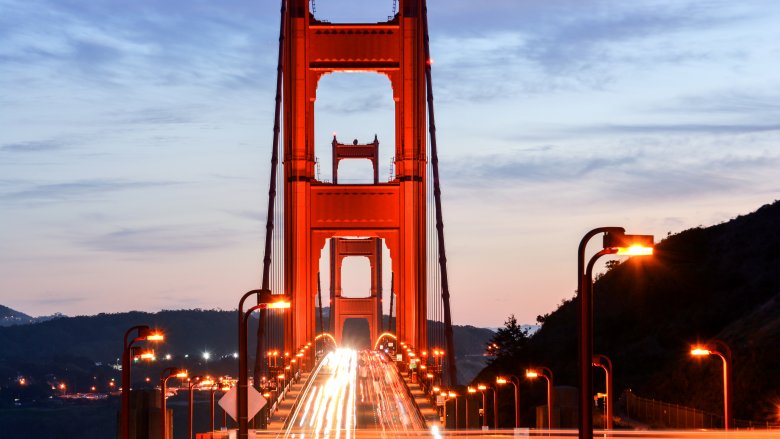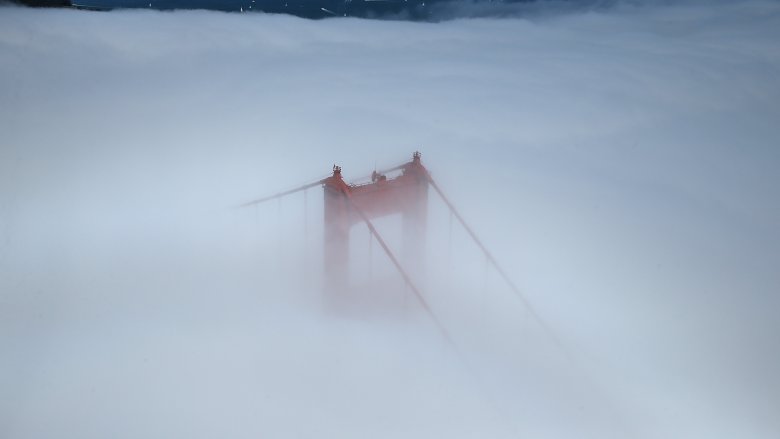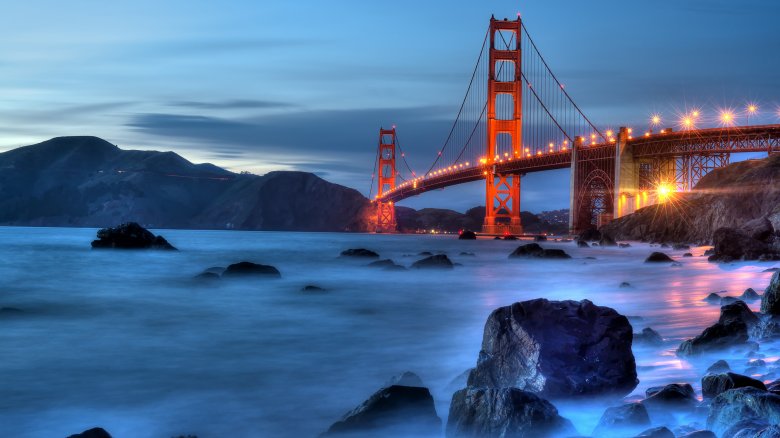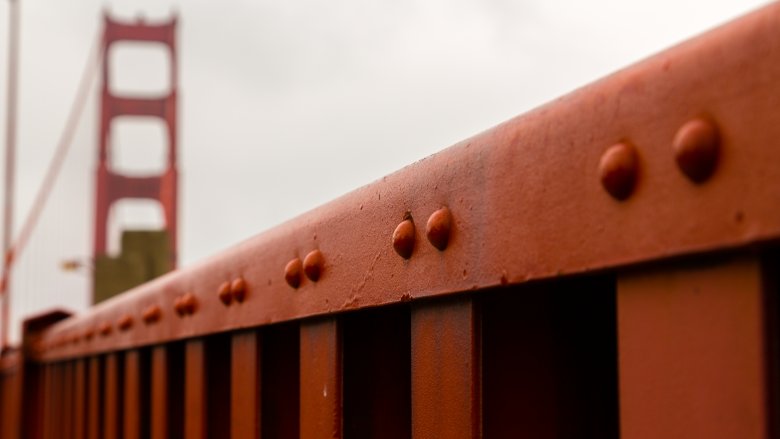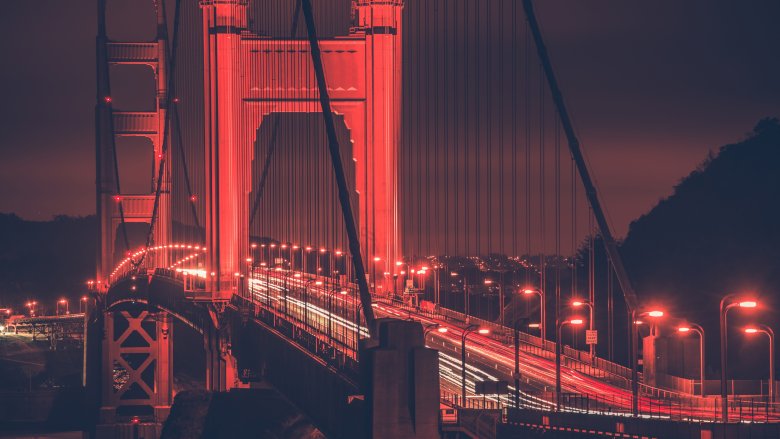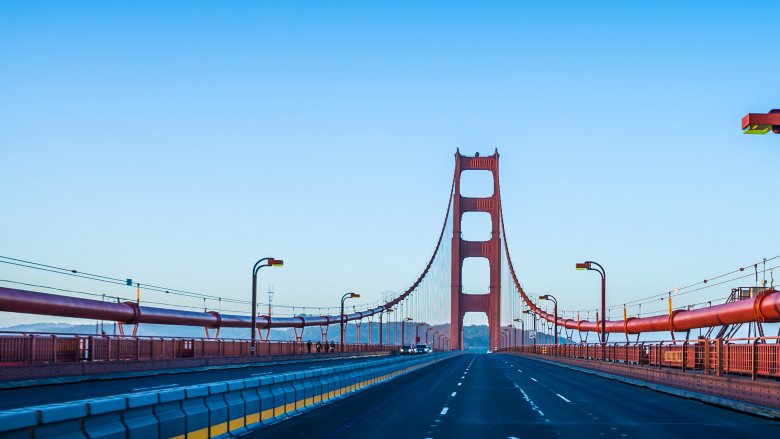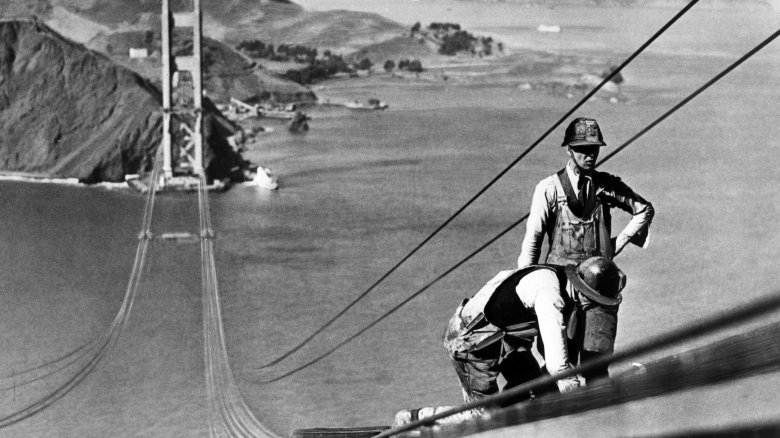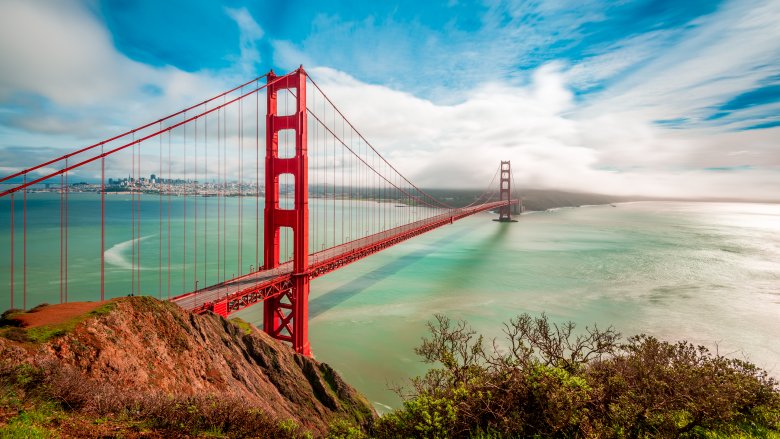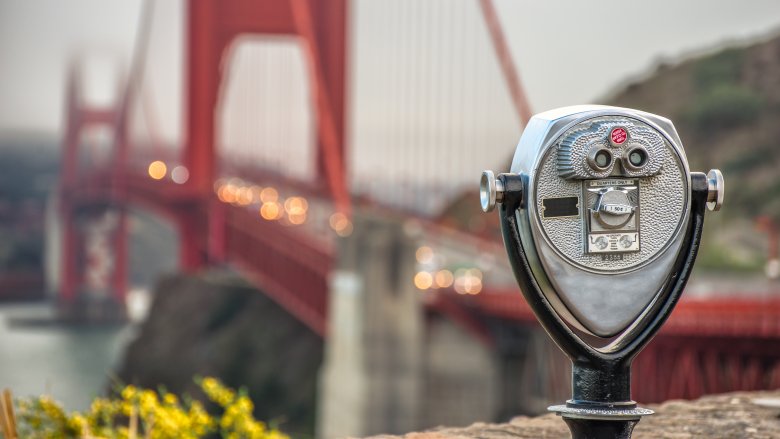Weird Things That Have Happened At The Golden Gate Bridge
The Golden Gate Bridge is one of the most recognizable places in the U.S., and when it comes to bridges, it's one of the world's most famous. Countless people have crossed it, looked at it, and photographed it. That's all to be expected when you build a massive metal thing and paint it like it's on fire. But you wouldn't expect all these weird things that have happened there.
It has weird effects on the weather
If you haven't seen them before, you've now seen at least one picture of the Golden Gate Bridge enveloped in fog, but you may not have realized just how much of an impact the bridge has on the weather right around it. According to Tom Andrade, maintenance superintendent for the bridge (via The New York Times), several microclimates exist along the bridge. Temperatures can vary up to 20 degrees between one end and the other, and the difference between the bridge's surface and underside is even greater. He says even in the middle of summer, workers painting the underside of the bridge can expect to have trouble with their equipment freezing.
The Golden Gate Bridge Highway & Transportation District says the bridge changes the way fog moves, too. When it hits the bridge, it can build up an area of such high pressure that the fog is squished to the ground in a blanket that puts London's fog to shame. If you'd like to find out more about that fog, you could always ask ... him? His Twitter handle is @KarlTheFog.
Installing bridge barriers has taken a weirdly long time
The Golden Gate Bridge has the dubious distinction of being one of the most popular spots for those souls who are looking to end it all. According to the East Bay Times, the very first suicide took place just 10 weeks after the bridge opened, when a World War I veteran named Harold Wobbler jumped on August 7, 1937. Slate says the first proposals for installing suicide barriers on the bridge came in the 1950s, but it wasn't until 2017 that CBS News reported a stainless steel net was finally being installed on the bridge. That's too late for the 1,500 people (that we know about) who died there. What gives?
First, we know suicide deterrents work. A 2013 meta-analysis of other studies showed that suicide rates drop by around 85 percent when deterrents are installed. Sure, we haven't always had scientific studies backing that up, but ... common sense.
Aside from that, what was the biggest reason for not installing the barriers? Until 2005, the Golden Gate Bridge Highway & Transportation District opposed any deterrents that couldn't be proven completely, 100 percent effective at stopping suicides. That's only slightly less horrible than their other concern, which was that the addition of a barrier would ruin the bridge's aesthetics. You can't make this stuff up.
That orange color was originally the primer
Trying to picture the Golden Gate Bridge as being painted anything but orange is a struggle. It's iconic today, but it was never supposed to be that color.
According to Golden Gate Bridge spokeswoman Mary Currie (via NPR), everyone originally assumed the bridge would be the same boring color as most other bridges. But the Golden Gate Bridge was unique, and painting it black, silver, or grey meant it would blend in with the strait's foggy weather — dangerous for boat traffic. Gizmodo says that's when the War Department put their two cents in, and they opted for a "dazzle" camouflage striped pattern that would be visible no matter what the weather. They wanted either red and white or yellow and black, and we can all agree it's fortunate that eyesore never happened.
What did happen is that while the powers-that-be argued, the bridge was painted in bright orange primer to get it ready for whatever the final paint color would be. Consulting architect Irving Morrow liked the primer so much that he wrote a 29-page report detailing just why "international orange" was the perfect color, and everyone else agreed.
The Night Stalker's disposal site
Californians spent the summer of 1985 locking their doors as a hopeful protection against the serial killer and rapist the press dubbed the Night Stalker. Richard Ramirez was put away four years later (and died in 2010 of natural causes, according to CNN), but the investigation into his crimes was marred by a bizarre oopsie.
Dianne Feinstein was San Francisco mayor at the time, and she held a press conference on August 23, 1985, only days after the murder of a 69-year-old man in Lake Merced. She showed off a composite sketch of the Night Stalker, and went on to do what every cop show and crime drama says you should never do: tell the public about all the evidence the police had collected. That included ballistics information on the gun he was using and details about his distinctive size 11.5 Avia sneakers.
Law enforcement was outraged, and SF Weekly says Ramirez chose the Golden Gate Bridge to dispose of some of that evidence. He kept the gun, but walked to the middle of the bridge and threw away the sneakers that could have helped identify him.
It's lost weight
We're sorry to have to tell you that the Golden Gate Bridge has succeeded where so many of us have constantly and relentlessly failed: with weight loss.
According to the Golden Gate Bridge Highway & Transportation District, the bridge has shed a whopping 12,300 tons over the course of the decades. When it opened, it weighed in at about 894,000 tons, and that's including the anchorages and the approaches. As of 1986, that figure dropped to about 887,000 tons because of a redecking project. The concrete deck was replaced by a steel plate and just 2 inches of epoxy asphalt, dropping the weight a huge amount. If only it was that easy for the rest of us.
Woody Harrelson's bridge protest
In 1996, Woody Harrelson was arrested after climbing the Golden Gate Bridge at the head of teeny, tiny protest. According to The LA Times, about nine people protested the destruction of a 60,000-acre redwood forest. To his credit, Harrelson totally put his money where his mouth was and got training in mountain climbing before heading 200 feet up the bridge.
Later, the San Francisco Chronicle reported that a hemp-wearing Harrelson was pretty unrepentant about the hours-long traffic jam the stunt caused. While they played the free speech card, it was later reported that the government had responded by raising the fines for bridge climbers and trespassers. It was originally a misdemeanor that could end with a $1,000 fine and up to six months in jail, but it bumped up to $10,000 and up to a year in jail. That's probably not what Harrelson was going for, but hey, they got something accomplished.
Workers who fell and survived formed the Halfway to Hell Club
When your job has the potential to kill you any second of the day, you have to keep your sense of humor. The Golden Gate Bridge Highway & Transportation District says safety measures taken during the bridge's construction were revolutionary at the time, and some (like hard hats and headlamps) are still used today. In a refreshing first for humanity, a safety net was even installed under the bridge during construction. It saved the lives of 19 men, who celebrated by forming the Halfway to Hell Club.
The charter member was Al Zampa, but his survival is a pretty hairy story (via the Al Zampa Memorial Bridge Foundation). He slipped on a wet iron girder and hit the net ... which then hit the rocky ground beneath it. He broke four vertebrae and spent the next two years wearing a back brace, but you know what else he did? He went back and walked a bare girder on the Golden Gate Bridge, just to prove it hadn't gotten the better of him. During the bridge's 50th anniversary, reporters quoted him as saying, "I always say it takes 90 percent guts and 10 percent know-how."
Something helped save Kevin Hines
When most people attempt suicide by jumping off the Golden Gate Bridge, they succeed. When CBC News talked to Kevin Hines in 2016, he was one of only 36 people known to have survived a jump from the bridge. Hines did something amazing with his second chance at life, going on to speak candidly about those moments before, during, and after in hopes of spreading awareness about what pushes a person to take that often final step.
He's spoken about the instant regret, the will to live, and the realization that no life choice is truly unfixable, save that last one. He's also spoken about the sensation of being in the water with something, a something he never saw but which he credits with saving his life. The impact broke his back, but he says there was something in the water keeping him afloat until the Coast Guard arrived. It was only later that a witness told him they'd seen a sea lion swimming alongside him and keeping him above the water. Sounds unlikely, right? The story was corroborated by another witness. Christina Slager, director of Animal Care and Exhibitry at the Aquarium of the Bay told ABC News it sounded more like the behavior of a dolphin than a sea lion, but either way, there must have been some animal spirit watching over him that day. We want to believe.
Two teens did an insane climbing stunt
It's no secret that some people will do anything for a social media following. In 2017, Tommy Rector and Peter Teatime had an idea best described as "questionable" when they decided to climb the Golden Gate Bridge without pesky things like safety equipment or permission. Vice says while it was terrifying to watch, it wasn't just the height and potential for falling that was most terrifying. It was that no one knew they were doing it until the footage went viral.
They got the world's attention, and they also got the attention of the U.S. Department of Homeland Security and the California Highway Patrol. There were no alarms, no safeguards, and no alerts triggered that someone was getting up to shenanigans on the bridge, demonstrating some serious holes in bridge security. While they naturally found themselves facing trespassing charges and jail time, they also volunteered to help the U.S. sort out some of their security problems. That's some major chutzpah, but what did you expect from these guys?
Ostrich stops traffic
Traffic jams are a way of life when your commute involves a major U.S. city, doubly so when it involves a bridge. However, Golden Gate Bridge traffic was stopped in 2005 by the most unlikely of obstructions: an ostrich. The story definitely doesn't disappoint, and according to SF Gate, the escapee had recently been sprung from death row by a farmer named Ronald Love. Love rescued the bird from the butcher with intentions of taking her to his farm and keeping her around for her eggs. It was on the way to the farm that Love stomped on the gas and sent her smashing through the rear window of his van. She promptly picked herself up and headed off for her own sort of freedom, but was corralled after a joint effort by bridge officers, highway patrol, and a truck driver who was more helpful than those who stopped to just take pictures.
The story has a happy ending. The 6-foot bird suffered only minor road rash, and Love wasn't too fussed about it. "Strange things always seem to happen with ostriches," he said. Words to live by.
